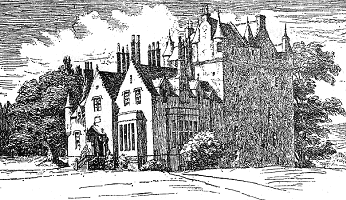|
 Cassillis
House stands by the Doon about three miles from Maybole. It is not known when it
was built, but Grose, the antiquarian, conjectures it to have been erected about
the time of Queen Mary, although it was probably earlier. The house was
considerably modernised in 1830, but the old tower still forms the main body of
the building while the Dule Tree (seen to the left in the engraving) waves its
branches, and the Doon sweeps past its walls as of yore. Cassillis
House stands by the Doon about three miles from Maybole. It is not known when it
was built, but Grose, the antiquarian, conjectures it to have been erected about
the time of Queen Mary, although it was probably earlier. The house was
considerably modernised in 1830, but the old tower still forms the main body of
the building while the Dule Tree (seen to the left in the engraving) waves its
branches, and the Doon sweeps past its walls as of yore.
The
history of Cassillis is uneventful, and it would probably never have been heard
of half a mile from the parish in which it stands had it not been for a romantic
story which has carried its fame far and wide. Here is the story:
The
gypsies cam' to oor gude lord's yett,
And O, but they sang sweetly;
They sang sae sweet and sae very complete,
That doon cam' oor fair ladye.
As
sune as they saw her weel-faured face
They coist the glamour ower her.
"O
conie wi' me," says Johnnie Fan,
"O, come wi' me, my deane,
For I vow aud I swear by the hilt o' my sword,
That your lord shall nae mair come near ye."
And
when oor Lord cam' hame at e'en,
And speered for his fair ladye,
The tane she cried, and the ither replied,
"She 's awa' wi' the gypsy laddie."
"Gae
saddle to me the black, black steed,
Gae saddle and mak' him ready.
Before that 1 either eat or sleep,
I 'll gae seek my fair ladye."
And
we were fifteen wed-made men,
Although we werna bonny,
And we were a' put doon but ane,
For a fair young, wanton ladye.
Such
is the story; and if any one asks for proof of the truth of it, all we can say
is that the ballad is our authority. And ballads, although not exactly
historical, are generally founded on fact; and while granting that we cannot
point to any particular date, or any particular person, we hold that an event
once happened in connection with Cassillis, such as the old ballad describes.
Besides
the Dule Tree and the "Gypsie's Steps," there is little of interest to
be seen about Cassillis now; but twenty years ago, the visitor to the old place
was shewn the tearful portrait of the run-away lady herself, arid a piece of
tapestry wrought by her, depicting the elopement, both of which have now
disappeared; while a trap door used to be uplifted revealing the old dungeon of
Cassillis, whence "cart-loads of human bones were once removed, telling, it
was to be feared, of deeds and times long gone by, when the devoted guest or the
refractory vassal went so frequently amissing, having met a fate which some
might suspect, but none durst inquire into." The reader who can receive
this as historical need not scruple to receive Johnnie Fan's story too
Table
of Contents
|